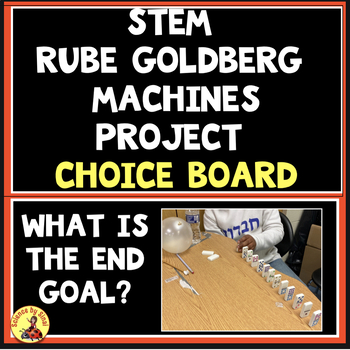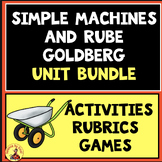Rube Goldberg STRUCTURED STEM PROJECT CHOICE BOARD What is the End Goal?
- PPTX
Also included in
- Here are 7 resources introducing simple machines and then having the students create a very structured Rube Goldberg machine as part of a force and motion unit. Please look closely at the descriptions of each of the 7 products. Included in this resource:Structured Rube Goldberg Machines Project withPrice $20.80Original Price $26.00Save $5.20
- Add structure and assessment to your fun Rube Goldberg, critical thinking engineering project during a forces/motion unit while discussing the change in kinetic energy as it is transferred from one object to another. Two project based learning resources in this mini bundle with the Rube Goldberg StPrice $5.60Original Price $7.00Save $1.40
Description
Here is a project choice board for your fun Rube Goldberg, critical thinking engineering project during a forces/motion and simple machines unit . Low prep and super fun end of year project based learning! There are 24 END GOAL ideas that take about the same amount of time and hit a range of student skills.
This resource includes:
- Teacher Notes
- Rube Goldberg End Goal Choice Board
- Grading Rubric
Please visit my blog to see how I use this resource in my classroom. How to Create a Rube Goldberg Unit plus a Free Simple Machines Review Set.
I would love your feedback if you purchase this product! Thank you!
Related products:
SIMPLE MACHINES iPad Schoolyard Scavenger Hunt Google Slides Activity
REAL LIFE SITUATIONS Newton's Laws of Motion PHOTO PROMPT TASK CARDS MS-PS2
There are several methods I use to get this resource to students.
- Since this is a PowerPoint, I simply upload it into a Google slides presentation and share it on Google Classroom with each individual student. The students can then copy which slides they want and paste them into their own Google Slides unit presentation and add text boxes.
- You can export the PowerPoint into images and then send the images to them in Google Classroom.
- You can download the PowerPoint into images and place all of the images into a Google Drive folder to share with the students.
- If you are using iPads, in the same room as the students, you can simply AirDrop the images, Powerpoint or Google Slides presentation to their iPads .
If you have any questions at all, as to how to use these, please contact me at Karensinai2@gmail.com and I am more than happy to help you!
Feedback
**Did you know that you can save money on TpT resources by leaving feedback? Go to your “My Purchases“ page and leave feedback on the resources you’ve purchased to earn TpT credits!
Copyright.
Each purchase is a license for ONE person to use in a classroom setting. It is a violation for individuals, schools and districts to redistribute, edit, sell, or post this item on the Internet or to other individuals. Disregarding the copyright is a violation of the Digital Millennium Copyright Act and subject to legal action. By purchasing this product you acknowledge that you have read and understood these terms of use.






